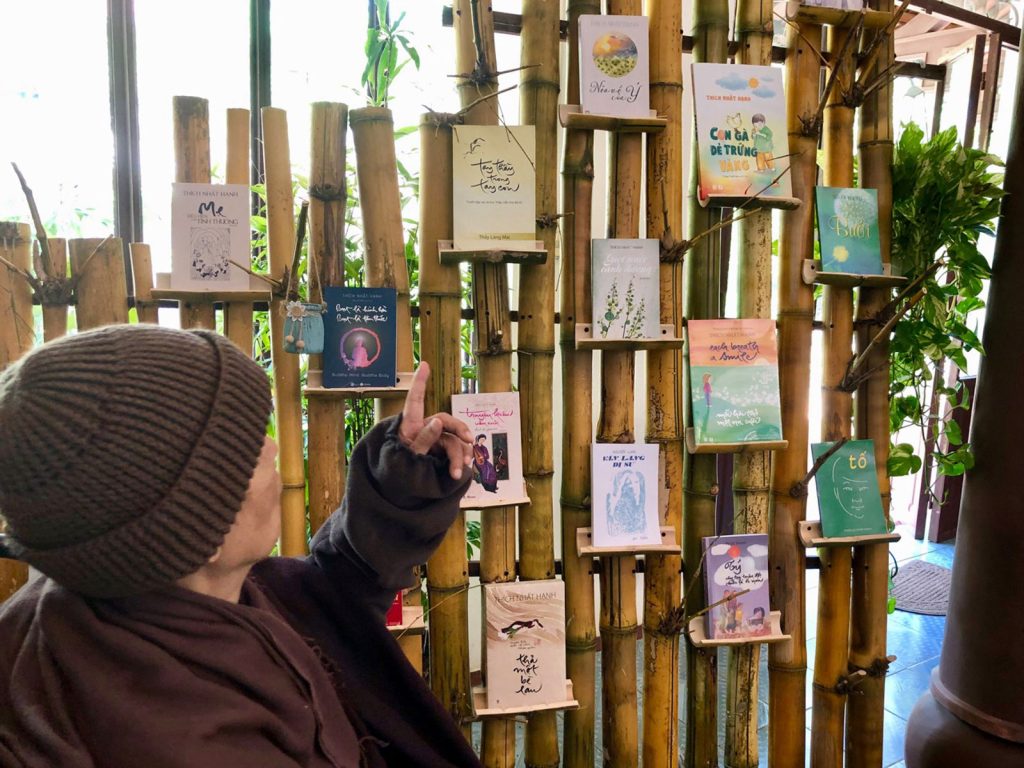Nothing is permanent, everything is precious. Here’s a selection of some happenings—fleeting and otherwise—in the Buddhist world this week.
Happy 93rd Birthday, Thich Nhat Hanh!
Thich Nhat Hanh celebrated his birthday on October 11, marking 93 years since the revered Buddhist teacher has (mindfully) walked on this earth. “Thay,” as he is affectionately known to his followers, spent the day at Tu Hieu Temple in Hue, Vietnam, where he first began monastic life at age sixteen. According to a statement by Plum Village, Thich Nhat Hanh’s international sangha network, monks and nuns came from across Vietnam to honor their teacher, and installed an exhibition of his books in the temple’s meditation hall. While Thay’s health remains fairly stable, the bestselling author of Being Peace lost the ability to speak after suffering a stroke in 2014, and is now in a wheelchair. Plum Village also indicated that it considers partaking in the current wave of climate activism as an important part of maintaining Thich Nhat Hanh’s legacy of engaged Buddhism. “Knowing that we are Thay’s continuation, we are coming together as a Sangha to support worldwide efforts to incite change and protect the Earth,” the statement reads. “The Earth-Holders network of sanghas [a Plum Village initiative for climate action] has put out a call to support the student climate strikes. . . .In August, we had our biggest ever Wake Up Earth retreat, with over 500 young people. . .from all around the world, including a delegation from Palestine and 10 young members of Extinction Rebellion who were sponsored to come and join the retreat.” Tricycle extends its sincerest birthday wishes to Thay.
Extradition Treaty Between China and Nepal Shelved
A proposed extradition treaty between China and Nepal has been shelved, according to reporting by Tibetan news site Phayul.com. The treaty, which would have been signed during a recent visit to Nepal by Chinese president Xi Jinping, allows Beijing and Kathmandu to hand over suspected criminals to the jurisdiction of their respective governments, putting some 20,000 exiled Tibetans who live in Nepal at increased risk for arrest. Nepalese media reported that the treaty was dropped due to “local opposition” and fears of infringing upon the sovereignty of Nepal. While this particular pact was left unsigned, Xi left the Himalayan nation on Sunday having endorsed “18 memorandums of understanding” and “two letters of intent for developmental and infrastructure deals,” which include a trans-Himalayan railway and tunneling projects. In recent years, Nepal has increasingly aligned itself with the policies of its northern neighbor. Xi’s two-day visit saw the arrest of 22 people, including 11 pro-Tibet activists and 11 Nepalese human rights activists. Over 80 Tibetans were also “blacklisted”: a source told Phayul that Tibetans who are associated with pro-Tibet demonstrations and celebrations for His Holiness the 14th Dalai Lama’s birthday were either detained or kept under supervision by Nepalese special forces during Xi’s visit.
Museum in Afghanistan Restores Ancient Buddhist Artifacts
In 2001 the Taliban destroyed a number of 3rd-century Buddhist artifacts, including two giant buddha states in the region of Bamyan, and smaller objects excavated from monasteries, in an attempt to erase the vestiges of a pre-Islamic past in Afghanistan. Today, with the help of the University of Chicago’s Oriental Institute, conservators at the National Museum of Afghanistan are restoring the artifacts that the militant Islamic group damaged 18 years ago, objects which testify to the region’s potent historical connections to Buddhism. “[This restoration work is] very important because it is actually restoration of our heritage, our identity, our past,” said Mohammad Fahim Rahimi, director of the museum told Reuters. “Buddhism was practiced here for more than 1,000 years. That’s a very large part of our history.” While efforts to repair the objects began after the Taliban government fell in 2001, the more recent US-backed restoration project aims to reassemble thousands of broken pieces into statues within the next three years. Photos show dozens of chipped Gandhara-style buddha faces, ears, noses, and sections of Shakyamuni’s trademark curly hair. Conservator Sherazuddin Saif recalls working for the museum under the Taliban before the US invasion. “They [the Taliban] wanted us to tell them the number of antiquities and we ignored their request, but some days later they came and started breaking the antiquities,” he said. US peace talks with the Taliban about withdrawing US troops came to a standstill last month, but the idea of including the Taliban in power-sharing deals in the region worries museum director Rahimi, who is exploring options for moving the artifacts to another location if it appears they are threatened again. But a spokesman for the Taliban, Suhail Shaheen, told Reuters that the group has no plans to harm any more Buddhist objects, stating, “All antique artifacts will be preserved in their place. They should be preserved for the history and culture education of the upcoming generations.”
Dhammananda Bhikkhuni Named One of BBC’s Influential Women
This week the BBC revealed its 2019 list of “inspiring and influential women” from around the globe, highlighting the contributions of female activists, politicians, artists, and athletes. Dhammananda Bhikkhuni, the first woman to receive full monastic ordination as a bhikkhuni in the Theravada tradition in Sri Lanka, was featured for her role as “Thailand’s first female monk,” and her position as abbess of Songdhammakalyani monastery, the only monastery for fully ordained nuns in Thailand. Although full ordination for female monastics died out in Thailand, Sri Lanka, Laos, and Burma between the 11th and 13th centuries, efforts by both Western and Asian nuns in the last 30 years have begun to reinstate the bhikkhuni order in Theravada Buddhist countries by soliciting the help of fully ordained nuns in Mahayana countries like Taiwan and Korea.
Thank you for subscribing to Tricycle! As a nonprofit, we depend on readers like you to keep Buddhist teachings and practices widely available.
